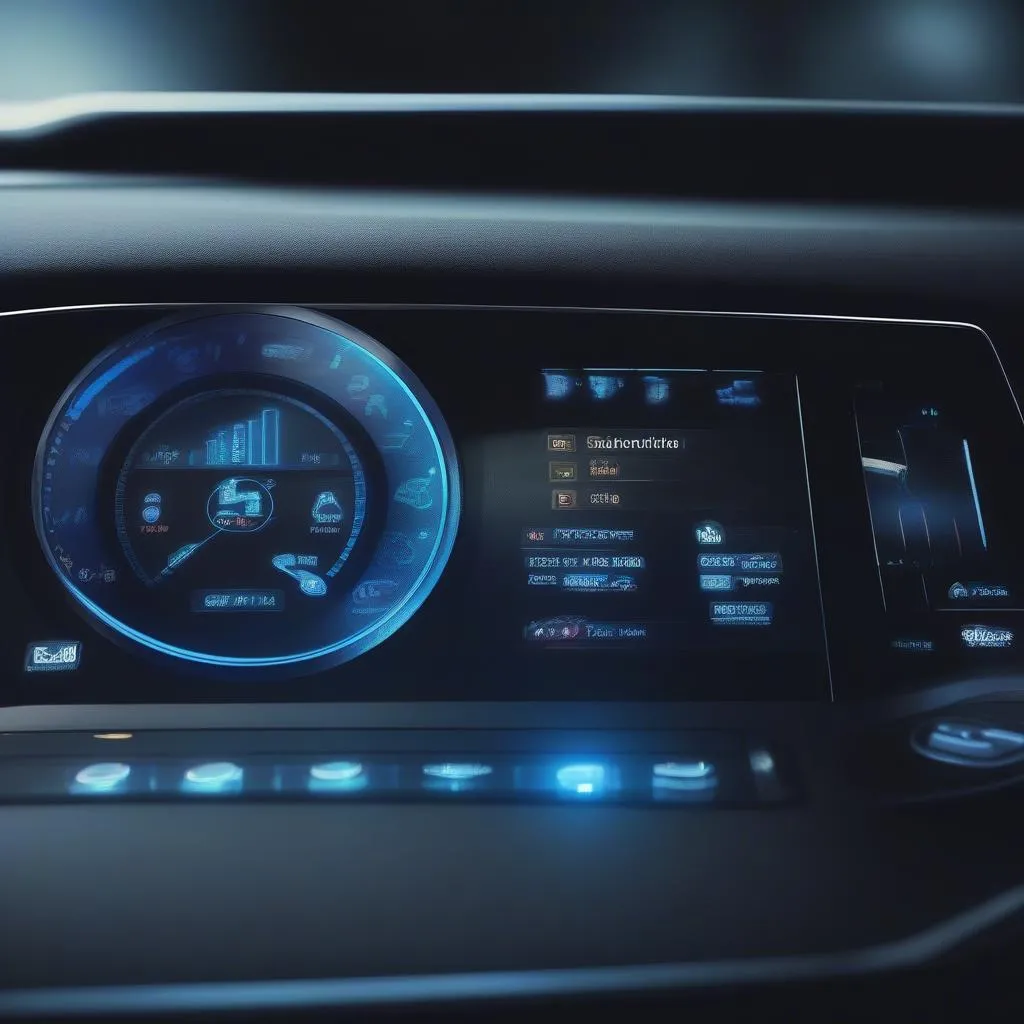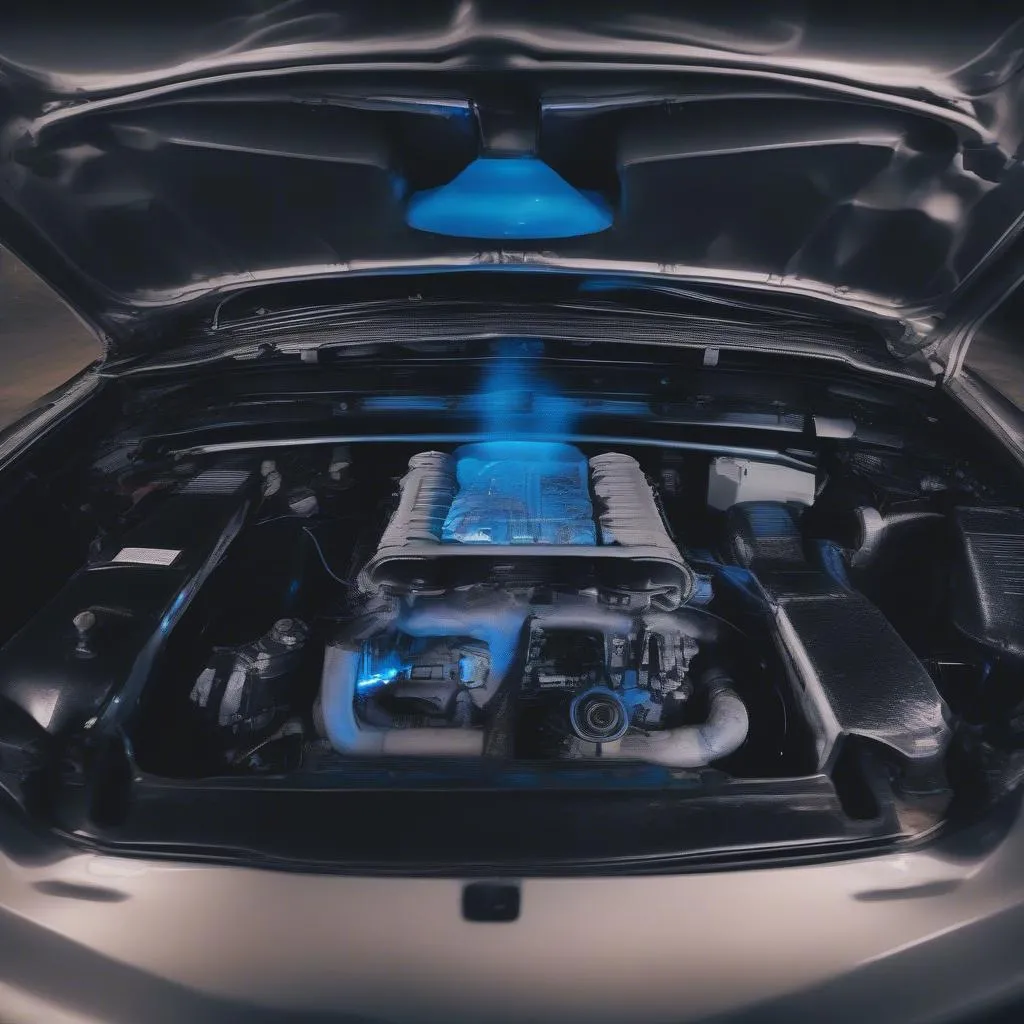Have you ever noticed a blue light flickering on your dashboard, or perhaps a blue light emanating from under the hood of your car? You’re not alone! Many car owners have encountered this mysterious blue light, often wondering what it means and if it’s something to worry about. Let’s delve into the world of Car Blue Lights, exploring the various reasons behind their appearance and what they might signify.
What Does a Blue Light in a Car Mean?
The presence of a blue light in your car can indicate a variety of things, depending on its location and context. Here’s a breakdown of the common scenarios:
Blue Light on the Dashboard
1. Bluetooth Connectivity: Many modern cars utilize Bluetooth technology for hands-free calling, music streaming, and more. A blue light on the dashboard might signify an active Bluetooth connection, indicating that your phone is paired with your car’s infotainment system.
2. Diagnostic Trouble Codes: Sometimes, a blue light on the dashboard might be part of a diagnostic code display. If your car’s computer system detects a fault, it might illuminate a blue light, along with specific codes displayed on the instrument cluster. This often signals a problem with the car’s electrical system, requiring a professional diagnosis.
3. Auxiliary Lighting Systems: Some cars have optional auxiliary lighting systems, such as fog lights or daytime running lights. These lights may have a blue hue, and their activation might be accompanied by a blue light indicator on the dashboard.
4. Aftermarket Modifications: It’s also possible that a blue light on your dashboard is a result of aftermarket modifications. For instance, aftermarket navigation systems or other electronic add-ons might utilize blue LED lights for their interfaces.
Blue Light Under the Hood
1. Electrical Components: When a blue light is seen under the hood, it usually points to a problem with an electrical component. It could be an indication of a faulty electrical wire, a blown fuse, or a malfunctioning sensor. This light might also signal a short circuit, which is a serious electrical fault that should be addressed promptly by a qualified mechanic.
2. HID Headlights: Modern cars often feature high-intensity discharge (HID) headlights, which are known for their bright, bluish-white light. These headlights often have a blue-tinted lens or a blue-colored housing, which might create the impression of a blue light emanating from them.
3. LED Lighting: With the rise of LED technology, many modern cars are equipped with LED lights for their headlights, taillights, and even interior illumination. These LED lights can emit a blue hue, particularly in some models.
Troubleshooting Car Blue Lights
If you encounter a blue light in your car, the first step is to consult your owner’s manual. The manual will often provide information on the specific meaning of blue lights in your car model. If the manual doesn’t offer specific details, it’s best to consult a trusted mechanic.
How to Fix Car Blue Lights
The method of fixing car blue lights depends on the underlying cause. For example, if the blue light is a result of a Bluetooth connection, simply disconnect your phone from the car’s Bluetooth system. However, if the blue light is associated with a diagnostic trouble code, you will need a qualified mechanic to diagnose and repair the problem.
What About Car Blue Lights and Safety?
While a blue light in your car might seem alarming, it’s not always a cause for immediate panic. In many cases, the blue light simply indicates an active system or a minor issue. However, if the blue light is accompanied by other unusual symptoms, such as a loss of power or a strange noise, it’s crucial to have your car inspected by a mechanic as soon as possible.
Frequently Asked Questions about Car Blue Lights:
1. Is it normal for a car to have a blue light?
The presence of a blue light in your car is not inherently abnormal. Many modern cars feature blue lights for various functions, such as Bluetooth connectivity, HID headlights, or LED lighting. However, if you notice a new or unusual blue light, it’s best to consult your owner’s manual or a mechanic to determine its meaning.
2. What does a blue light on the dashboard mean?
As discussed above, a blue light on the dashboard can mean a variety of things, including a Bluetooth connection, a diagnostic code, an activated auxiliary lighting system, or an aftermarket modification.
3. What does a blue light under the hood mean?
A blue light under the hood usually indicates a problem with an electrical component, such as a faulty wire, a blown fuse, or a malfunctioning sensor. It’s essential to diagnose the problem and have it repaired by a qualified mechanic.
4. Is a blue light in my car a sign of a serious problem?
Not necessarily. While a blue light might signal an issue, it’s not always a cause for immediate concern. If you notice a blue light accompanied by other unusual symptoms, it’s best to have your car inspected by a mechanic.
Explore More on Car Blue Lights & Diagnostics Tools:
For a more comprehensive understanding of car diagnostics, consider exploring these additional articles on our site:
- Blue Temperature Light in Car
- Bluetooth OBD-II Transmitter Lights
- Car Dealer Open on Sunday Near Me
- Reflective Window Tint for Cars
- Bluetooth OBD-2 Scanners
Need Help with Your Car?
Do you have questions about your car’s diagnostics or need assistance with a specific issue? Don’t hesitate to reach out to our team of automotive experts. We’re available 24/7 to offer advice and support. Contact us via WhatsApp: +84767531508
 Blue Light on a Car Dashboard
Blue Light on a Car Dashboard
 Blue Light Under the Hood
Blue Light Under the Hood
 Mechanic Inspecting a Car
Mechanic Inspecting a Car
We hope this article has provided you with a clear understanding of car blue lights and what they might signify. Keep in mind that while blue lights can be a source of curiosity, they’re not always a cause for alarm. If you’re ever unsure, it’s always best to consult a qualified mechanic.